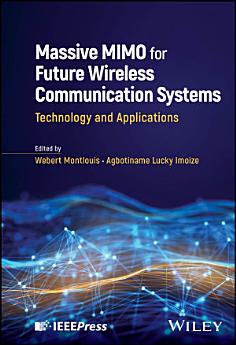Massive MIMO for Future Wireless Communication Systems: Technology and Applications
About this ebook
Massive MIMO for Future Wireless Communication Systems analyzes applications and technology trends for massive multiple input multiple output (MIMO) in 6G and beyond, presenting a unified theoretical framework for analyzing the fundamental limits of massive MIMO that considers several practical constraints. In addition, this book develops advanced signal-processing algorithms to enable massive MIMO applications in realistic environments.
The book looks closer at applying techniques to massive MIMO in order to meet practical network constraints in 6G networks, such as interference, pathloss, delay, and traffic outage, and provides new insights into real-world deployment scenarios, applications, management, and associated benefits of robust, provably secure, and efficient security and privacy schemes for massive MIMO wireless communication networks.
To aid in reader comprehension, this book includes a glossary of terms, resources for further reading via a detailed bibliography, and useful figures and summary tables throughout.
With contributions from industry experts and researchers across the world and edited by two leaders in the field, Massive MIMO for Future Wireless Communication Systems includes information on:
- Signal processing algorithms for cell-free massive MIMO systems and advanced mathematical tools to analyze multiuser dynamics in wireless channels
- Bit error rate (BER) performance comparisons of different detectors in conventional cell-free massive MIMO systems
- Enhancement of massive MIMO using deep learning-based channel estimation and cell-free massive MIMO for wireless federated learning
- Low-complexity, self-organizing, and energy-efficient massive MIMO architectures, including the prospects and challenges of Terahertz MIMO systems
Massive MIMO for Future Wireless Communication Systems is an essential resource on the subject for industry and academic researchers, advanced students, scientists, and engineers in the fields of MIMO, antennas, sensing and channel measurements, and modeling technologies.
About the author
Webert Montlouis (Fellow, IEEE) received the PhD degree in electrical and computer engineering from Northeastern University, Boston, MA, USA. He is currently with Johns Hopkins University, Baltimore, MD. He has served as Chief Scientist at the Applied Physics Laboratory (APL) and faculty in the Electrical and Computer Engineering department. He has been the chair of the IEEE Massive MIMO standard development working group. He is also the co-Chair of the Massive MIMO working group. Dr, Montlouis served as general co-Chair of the first IEEE Massive MIMO workshop and served as session chair for many IEEE conferences. His research interests are in the areas Multi-Channel System Architecture, Sensing, Next Generation Radar Systems, Wireless Communications 5G and Beyond, Quantum Information Science, Digital signal Processing and Biomedical Signal Processing. He is a Fellow of the IEEE and a member of the IEEE Signal Processing and Communications Societies.
Agbotiname Lucky Imoize is a Lecturer in the Department of Electrical and Electronics Engineering at the University of Lagos, Nigeria. Previously, he was a Research Scholar at the Ruhr University Bochum, Germany. He is a Fulbright fellow and a Senior Member of the IEEE.






